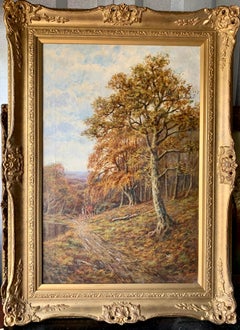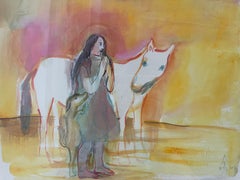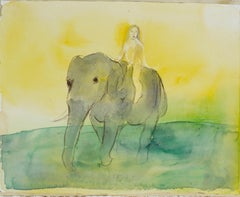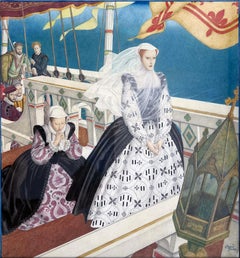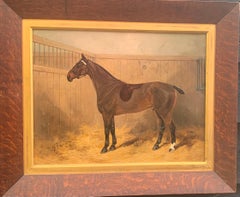Victorian Figurative Paintings
to
1
2
2
2
2
2
2
1
1
Overall Height
to
Overall Width
to
93
66
53
32
17
5
1
1
1
4
1
1
1
1
1
1
1
2
465
146
5
13
4
4
1
1
1
2
1
1
4
3
2
2
1
Style: Victorian
Period: 1920s
Cute Children's Book Illustration British Female Illustrator - Teddy Bears
Located in Miami, FL
A British Female Illustrator paints a warm and fuzzy scene from a child's imagination, with ducks and teddy bears gazing at a "Mr Willoughby's eyeglass" standing on it's edge as it l...
Category
1920s Victorian Figurative Paintings
Materials
Watercolor, Gouache
Antique English Fox hunting scene with huntsman jumping with hounds in a field
Located in Woodbury, CT
Tom Ivester Lloyd 1871-1942 was a fine artist who worked mainly in water colour but was also very accomplished in oils.
He served in the first war and produced pictorial records which are now in the army museum. He was a keen hunting man and was Master of the Sherrington Foot Beagles.
He was a great hound man and wrote and illustrated a book on hounds.
Acquiring an early 20th-century English fox hunting...
Category
1920s Victorian Figurative Paintings
Materials
Oil, Board
English Victorian Antique landscape, Figures gathering Primroses
Located in Woodbury, CT
English Victorian Antique landscape, Figures gathering Primroses. Cowleigh Woods, North Malvern, UK
John Bates Noel was born John Noel Bates in Worcester in 1870. He was the son of ...
Category
1920s Victorian Figurative Paintings
Materials
Canvas, Oil
English early 20th century landscape with fox hunters, hounds on horse back
Located in Woodbury, CT
Arthur Willett British 1868 -1951. Willett was a renowned landscape artist who settled in Brighton but his paintings of the British countryside and country pursuits are highly sought...
Category
1920s Victorian Figurative Paintings
Materials
Canvas, Oil
Related Items
Expressionist Figurative water color painting- Series The Horse Whisper No.2-25
Located in Beijing, CN
Expressionist Figurative water color painting by Zhang Chunyang
Series The Horse Whisper No.2-25
Dimension: 29 x 36 cm
Material: Gouache, Watercolor on Paper
Date: 2013
Artist B...
Category
2010s Victorian Figurative Paintings
Materials
Watercolor, Gouache, Handmade Paper
Zhang ChunyangExpressionist Figurative water color painting- Series The Horse Whisper No.2-25 , 2013
Free Shipping
H 11.42 in W 14.18 in
Expressionist Figurative water color painting- Luckiness
Located in Beijing, CN
Expressionist Figurative water color painting by Zhang Chunyang
Title: Luckiness
Dimension: 29 x 36 cm
Material: Gouache, Watercolor on Paper
D...
Category
2010s Victorian Figurative Paintings
Materials
Watercolor, Gouache, Handmade Paper
Free Shipping
H 11.42 in W 14.18 in
The Abduction of the Sabine Women , a Renaissance drawing by Biagio Pupini
Located in PARIS, FR
This vigorous drawing has long been attributed to Polidoro da Caravaggio: The Abduction of the Sabine Women is one of the scenes that Polidoro depicted between 1525 and 1527 on the façade of the Milesi Palazzo in Rome. However, the proximity to another drawing inspired by this same façade, kept at the Ecole des Beaux-Arts, and to other drawings inspired by Polidoro kept at the Musée du Louvre, leads us to propose an attribution to Biagio Pupini, a Bolognese artist whose life remains barely known, despite the abundant number of drawings attributed to him.
1. Biagio Pupini, a Bolognese artist in the light of the Roman Renaissance
The early life of Biagio Pupini, an important figure of the first half of the Cinquecento in Bologna - Vasari mentions him several times - is still poorly known. Neither his date of birth (probably around 1490-1495) nor his training are known. He is said to have been a pupil of Francesco Francia (1450 - 1517) and his name appears for the first time in 1511 in a contract with the painter Bagnacavallo (c. 1484 - 1542) for the frescoes of a church in Faenza. He then collaborated with Girolamo da Carpi, at San Michele in Bosco and at the villa of Belriguardo.
He must have gone to Rome for the first time with Bagnacavallo between 1511 and 1519. There he discovered the art of Raphael, with whom he might have worked, and that of Polidoro da Caravaggio. This first visit, and those that followed, were the occasion for an intense study of ancient and modern art, as illustrated by his abundant graphic production.
Polidoro da Caravaggio had a particular influence on the technique adopted by Pupini. Executed on coloured paper, his drawings generally combine pen, brown ink and wash with abundant highlights of white gouache, as in the drawing presented here.
2. The Abduction of the Sabine Women
Our drawing is an adaptation of a fresco painted between 1525 and 1527 by Polidoro da Caravaggio on the façade of the Milesi Palace in Rome. These painted façades were very famous from the moment they were painted and inspired many artists during their stay in Rome. These frescoes are now very deteriorated and difficult to see, as the palace is in a rather narrow street.
The episode of the abduction of the Sabine women (which appears in the centre of the photo above) is a historical theme that goes back to the origins of Rome and is recounted both by Titus Livius (Ab Urbe condita I,13), by Ovid (Fasti III, 199-228) and by Plutarch (II, Romulus 14-19). After killing his twin brother Romus, Romulus populates the city of Rome by opening it up to refugees and brigands and finds himself with an excess of men. Because of their reputation, none of the inhabitants of the neighbouring cities want to give them their daughters in marriage. The Romans then decide to invite their Sabine neighbours to a great feast during which they slaughter the Sabines and kidnap their daughters.
The engraving made by Giovanni Battista Gallestruzzi (1618 - 1677) around 1656-1658 gives us a good understanding of the Polidoro fresco, allowing us to see how Biagio Pupini reworked the scene to extract this dynamic group.
With a remarkable economy of means, Biagio Pupini takes over the left-hand side of the fresco and depicts in a very dense space two main groups, each consisting of a Roman and a Sabine, completed by a group of three soldiers in the background (which seems to differ quite significantly from Polidoro's composition).
The balance of the drawing is based on a very strongly structured composition. The drawing is organised around a median vertical axis, which runs along both the elbow of the kidnapped Sabine on the left and the foot of her captor, and the two main diagonals, reinforced by four secondary diagonals. This diamond-shaped structure creates an extremely dynamic space, in which centripetal movements (the legs of the Sabine on the right, the arm of the soldier on the back at the top right) and centrifugal movements (the arm of the kidnapper on the left and the legs of the Sabine he is carrying away, the arm of the Sabine on the right) oppose each other, giving the drawing the appearance of a whirlpool around a central point of support situated slightly to the left of the navel of the kidnapper on the right.
3. Polidoro da Caravaggio, and the decorations of Roman palaces
Polidoro da Caravaggio was a paradoxical artist who entered Raphael's (1483 - 1520) workshop at a very young age, when he oversaw the Lodges in the Vatican. Most of his Roman work, which was the peak of his career, has disappeared, as he specialised in facade painting, and yet these paintings, which are eminently visible in urban spaces, have influenced generations of artists who copied them abundantly during their visits to Rome.
Polidoro Caldara was born in Caravaggio around 1495-1500 (the birthplace of Michelangelo Merisi, known as Caravaggio, who was born there in 1571), some forty kilometres east of Milan. According to Vasari, he arrived as a mason on the Vatican's construction site and joined Raphael's workshop around 1517 (at the age of eighteen according to Vasari). This integration would have allowed Polidoro to work not only on the frescoes of the Lodges, but also on some of the frescoes of the Chambers, as well as on the flat of Cardinal Bibiena in the Vatican.
After Raphael's death in 1520, Polidoro worked first with Perin del Vaga before joining forces with Maturino of Florence (1490 - 1528), whom he had also known in Raphael's workshop. Together they specialised in the painting of palace façades. They were to produce some forty façades decorated with grisaille paintings imitating antique bas-reliefs.
The Sack of Rome in 1527, during which his friend Maturino was killed, led Polidoro to flee first to Naples (where he had already stayed in 1523), then to Messina. It was while he was preparing his return to the peninsula that he was murdered by one of his assistants, Tonno Calabrese, in 1543.
In his Vite, Vasari celebrated Polidoro as the greatest façade decorator of his time, noting that "there is no flat, palace, garden or villa in Rome that does not contain a work by Polidoro". Polidoro's facade decorations, most of which have disappeared as they were displayed in the open air, constitute the most important lost chapter of Roman art of the Cinquecento. The few surviving drawings of the painter can, however, give an idea of the original appearance of his murals and show that he was an artist of remarkable and highly original genius.
4. The façade of the Milesi Palace
Giovanni Antonio Milesi, who commissioned this palace, located not far from the Tiber, north of Piazza Navona, was a native of the Bergamo area, like Polidoro, with whom he maintained close friendly ties. Executed in the last years before the Sack of Rome, around 1526-1527, the decoration of Palazzo Milesi is considered Polidoro's greatest decorative success.
An engraving by Ernesto Maccari made at the end of the nineteenth century allows us to understand the general balance of this façade, which was still well preserved at the time. The frescoes were not entirely monochrome, but alternated elements in chiaroscuro simulating marble bas-reliefs and those in ochre simulating bronze and gold vases...
Category
16th Century Victorian Figurative Paintings
Materials
Ink, Gouache, Pen
19th Century genre oil painting of two gentlemen in a garden
Located in Moreton-In-Marsh, Gloucestershire
Frank Moss Bennett
British, (1874-1952)
In the Garden
Oil on panel, signed & dated 1917
Image size: 11 inches x 13.5 inches
Size including frame: 20 inches x 22.5 inches
A charming genre scene of two gentlemen in 18th century costume in a garden by Frank Moss Bennett. The men drink wine and eat fruit at a linen covered table...
Category
Early 20th Century Victorian Figurative Paintings
Materials
Oil, Panel
H 20 in W 22.5 in D 3.5 in
Freya (Seated Backwards), Mixed media on grey board
Located in London, GB
Howard Tangye (b.1948, Australia) has been an influential force in fashion for decades. Lecturing at London’s Central Saint Martins for 35 years, including 16 years as head of BA Wom...
Category
2010s Victorian Figurative Paintings
Materials
Other Medium, Archival Paper, Handmade Paper, Pen, Felt Pen, Permanent M...
Early 20th Century Worcestershire landscape oil painting of a plough team
Located in Moreton-In-Marsh, Gloucestershire
David Bates
British, (1840-1921)
The Plough Team, Bredon’s Norton
Oil on canvas, signed & dated 1908, further inscribed verso
Image size: 15.5 inches x 23.5 inches
Size including frame: 21.5 inches x 29.5 inches
A lovely landscape painting of a plough team on a country track near Bredon’s Norton by David Bates. Bredon’s Norton is a village located in the Cotswolds, on the slopes of Bredon Hill in South Worcestershire. The America women’s rights activist Victoria Woodhull Martin moved to the village in 1901 and by 1908 had set up an agricultural school for women at her Norton’s Park estate. The Antarctic explore Raymond Priestley also lived there. Although Bates was living in Surrey at the time of this painting, he would have been familiar with the area after having lived and worked in Worcestershire for some considerable time. He would have also most likely been aware of Victoria Woodhull Martin and the school.
David Bates was born in March, Cambridge in 1840 to Benjamin Bates a shoe maker and Sarah Bates. By 1851, the family had moved to Upton upon Severn in Worcestershire and from 1855 Bates became an apprentice at the Royal Worcester Porcelain Works in Worcester. There he developed his artistic talent, painting flower decorations onto vases and plates. At some point after 1861, he became a full time artist and made his debut at the Royal Academy in 1863, continuing to exhibit there until 1893. He also exhibited at the Royal Birmingham Society of Artists, Suffolk Street and the Grosvenor Gallery.
He married Elizabeth Higgs from Worcester in 1867 and they lived at Cherry Orchard, Bath Road in Worcester where their children were later born. Their second child John Bates Noel (1870-1927) became a landscape artist and their younger son David Samuel...
Category
19th Century Victorian Figurative Paintings
Materials
Oil, Canvas
H 21.5 in W 29.5 in D 2.5 in
Fine Large Victorian Oil Painting Scottish Loch Scene & Mountains at Sunset
Located in Cirencester, Gloucestershire
Artist/ School: British School, late 19th century, signed
Title: Sunset in the Scottish Highlands
Medium: oil on canvas
Framed: 25 x 35 inches
Canvas: 20 x 30 inches
Provenance: ...
Category
19th Century Victorian Figurative Paintings
Materials
Oil, Canvas
19th Century historical genre oil painting of English civil war soldiers
Located in Moreton-In-Marsh, Gloucestershire
Ernest Crofts
British, (1847-1911)
On the March
Oil on canvas, signed
Image size: 8.5 inches x 12.5 inches
Size including frame: 17 inches x 21 inches
A wonderful historical painti...
Category
19th Century Victorian Figurative Paintings
Materials
Canvas, Oil
19th Century, English School, Portrait of a traveller on a country road
Located in Harkstead, GB
A very skilfully drawn portrait of a traveller on a country road. The artist has meticulously captured the details of his dishevelled attire and his thoughtful expression.
English ...
Category
19th Century Victorian Figurative Paintings
Materials
Watercolor, Pencil, Paper
H 9 in W 5.75 in D 1 in
19th Century genre landscape oil painting of women picking flowers
Located in Moreton-In-Marsh, Gloucestershire
Thomas Brooks
British, (1818-1891)
Picking Flowers on a Coastal Path
Oil on canvas, signed & dated 1878
Image size: 15 inches x 10 inches
Size including frame: 20 inches x 15 inches...
Category
19th Century Victorian Figurative Paintings
Materials
Canvas, Oil
H 20 in W 15 in D 2 in
Antique Scottish Highlands Loch Landscape Figure by Cottage signed oil
By Joel Owen
Located in Cirencester, Gloucestershire
The Loch Keepers Cottage
by Joel B. Owen (British, signed and dated 1918)
oil painting on canvas: 20 x 30 inches
original antique gilt frame: 23 x 33 inches
condition: overall very g...
Category
Early 20th Century Victorian Figurative Paintings
Materials
Canvas, Oil
H 23 in W 33 in D 1 in
Historical oil painting of the surrender of Don Pedro De Valdez to Francis Drake
Located in Moreton-In-Marsh, Gloucestershire
John Seymour Lucas RA
British, (1849-1923)
The Surrender of Don Pedro De Valdez to Sir Francis Drake
Oil on canvas, signed & dated 1889
Image size: 19.5 inches x 30.5 inches
Size including frame: 27 inches x 38 inches
This fantastic historical scene by John Seymour Lucas depicts the surrender of Don Pedro De Valdez to Sir Francis Drake, aboard the Revenge during the Spanish Armada off Portland on 1 August, 1588. Don Pedro de Valdez was the commander of the Squadron of Andalusia and was on board the Nuestra Señora del Rosario when it was taken in action by Drake in the Revenge. A full sized version of this painting is held by the National Trust and can be found at Buckland Abbey, Devon.
John Seymour Lucas was born in London on 21 December, 1849 to Henry and Elizabeth Lucas (née Seymour). He was the nephew of the portrait painter John Lucas and two of his children, Sydney Seymour...
Category
19th Century Victorian Figurative Paintings
Materials
Oil, Canvas
Previously Available Items
Mary Queen of Scots
By Edmund Dulac
Located in Miami, FL
This is a work of ultra-high quality that could proudly hang in any major museum in the world. The closer the viewer gets to it, the more the painting reveals itself. Duluc must have painted this with the most refined brush. Stunningly detailed and rendered, Mary Queen of Scots was painted for the cover of the June 10, 1934, issue of American Weekly. It was part of Dulac's series Follies that destroyed famous Queens which also featured illustrations of Seiramis, Dido, Isabella of Bavaria, Marie-Antoinette, and Queen Chand (see previous lot).
Mary Queen of Scots
signed 'Edmund Dulac...
Category
1920s Victorian Figurative Paintings
Materials
Watercolor, Gouache, Pencil
19th century Victorian Antique Polo Pony or horse in a stable called Glengyle
Located in Woodbury, CT
A wonderful portrait of an English horse or Polo pony in a stable, called Glengyle Framed in its original English Antique Oak frame
Henry Frederick Lucas Lucas was born in Louth, Li...
Category
1920s Victorian Figurative Paintings
Materials
Oil, Wood Panel
19th century Victorian Antique Polo Pony or horse in a stable called Carlow
Located in Woodbury, CT
A wonderful portrait of an English horse or Polo pony in a stable, called Carlow, Framed in its original English Antique Oak frame
Henry Frederick Lucas Lucas was born in Louth, Lin...
Category
1920s Victorian Figurative Paintings
Materials
Oil, Wood Panel
1920's Antique English Impressionist harvest landscape with man and his dog.
By Frederick Thomas Daws
Located in Woodbury, CT
Wonderful English Impressionist early 20th century landscape. Frederick Thomas Daws was a well known painter from the latter part of the 19th century.
He exhibited at the Royal Acade...
Category
1920s Victorian Figurative Paintings
Materials
Oil
Free Shipping
H 24 in W 32 in
English 20th century portrait, the Racing Horse, Adams Apple, with a horseshoe
Located in Woodbury, CT
Unique horse portrait of the Racing Horse, Adams Apple, painted circa 1924.
Henry Frederick Lucas Lucas was born in Louth, Lincolnshire in 1848 to St. John Wells, a surgeon, and Lou...
Category
1920s Victorian Figurative Paintings
Materials
Oil, Wood Panel
English early 20th century Portrait of a seated Collie dog
Located in Woodbury, CT
English animal and dog painter from the early part of the 20th century. Her work was almost always horses of dogs and she had a very successful career painted and selling her work. T...
Category
1920s Victorian Figurative Paintings
Materials
Oil
Free Shipping
H 24 in W 32 in D 4 in
Victorian style Highland Scottish cattle and sheep in the wilds of Scotland
Located in Woodbury, CT
William Harold Watson was a member of possibly the best known family of Scottish painters of Highland cattle and sheep. He was the third generation of animal painters to specialize i...
Category
1920s Victorian Figurative Paintings
Materials
Oil
Victorian figurative paintings for sale on 1stDibs.
Find a wide variety of authentic Victorian figurative paintings available for sale on 1stDibs. Works in this style were very popular during the 21st Century and Contemporary, but contemporary artists have continued to produce works inspired by this movement. If you’re looking to add figurative paintings created in this style to introduce contrast in an otherwise neutral space in your home, the works available on 1stDibs include elements of orange and other colors. Many Pop art paintings were created by popular artists on 1stDibs, including Francis E. Jamieson, Frank Moss Bennett, David Bates b.1840, and Königliche Porzellan-Manufaktur (KPM). Frequently made by artists working with Paint, and Oil Paint and other materials, all of these pieces for sale are unique and have attracted attention over the years. Not every interior allows for large Victorian figurative paintings, so small editions measuring 5 inches across are also available. Prices for figurative paintings made by famous or emerging artists can differ depending on medium, time period and other attributes. On 1stDibs, the price for these items starts at $256 and tops out at $124,745, while the average work sells for $2,757.
Recently Viewed
View AllMore Ways To Browse
Gambling Painting
Mens Dress Form
Painting Of King Philip
National Vintage Radio
Charlie West
Ann Ray
D Perry
Oil Painting Asian Woman
Mickey Mouse Artwork
Monopoly Art Alec
Artist Patricia C
Alex Katz Blue
Male Academic Painting
Sunglasses Painting
Peter Moore
Potato Painting
Art And Antique Budapest
San Francisco China Town


